Our beautiful campus has more than 10 statues on campus dating back as early as 1901 and beautiful murals in the Rotunda. Student murals also have been integrated into campus through the years.
Statues on Campus
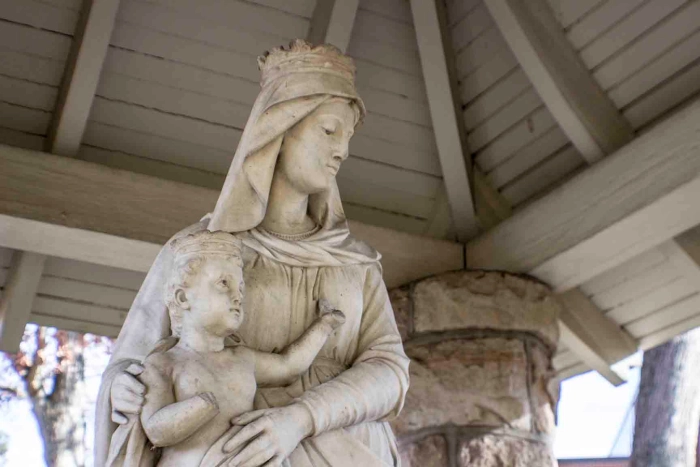
The Lackawanna and Wyoming Valley Railroad had announced a plan to extend its line from Scranton to Carbondale that cut directly across the Green Ridge property of Marywood. If the Railroad were granted the right of eminent domain to build, plans for the school would cease. Mother Cyril, Mother Superior at the time, requested a meeting with Railroad officials to represent and defend the interest of her Congregation. Mother Cyril single-handedly convinced the authorities to select an alternative route for their proposed extension. "So close was the brush with disaster and so great the relief at escaping it that two supporters of the IHM Sisters decided to commemorate the triumph in a physical form. The Reverend Daniel Dunn and his brother, Reverend John Dunn, donated funds for a shrine to Our Lady of Victory. The statue in its pavilion still stands today on the campus, midway between the Liberal Arts Building and Nazareth Hall, on the very spot where surveyors from the Railroad had been seen making their preliminary calculations." (page 10 of A Retrospective)
The Sisters of the IHM (on page 280) reveals that, each year on the last Sunday of May, the students, novices, and Sisters proceeded to the Shrine with the coronation of Mary. It had also been used as the "Throne of our Eucharistic Lord" during the solemn Corpus Christi processions.
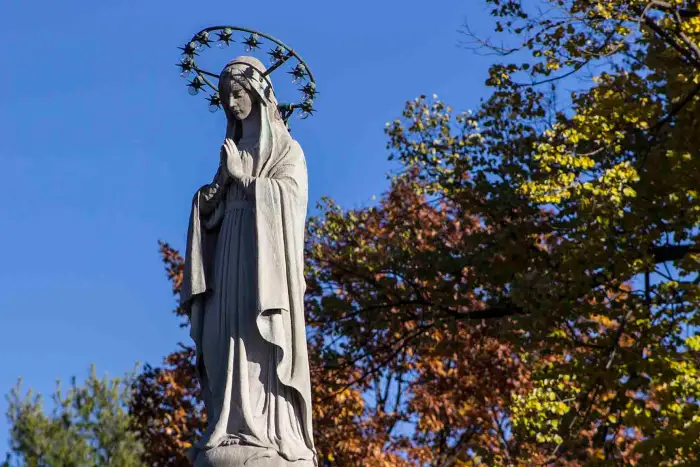
"Mount Saint Mary officially opened on September 8, 1902. Formal ceremonies climaxed with the dedication of the statue of the Blessed Mother which stood on the entrance arch of the campus." (page 11 of A Retrospective).
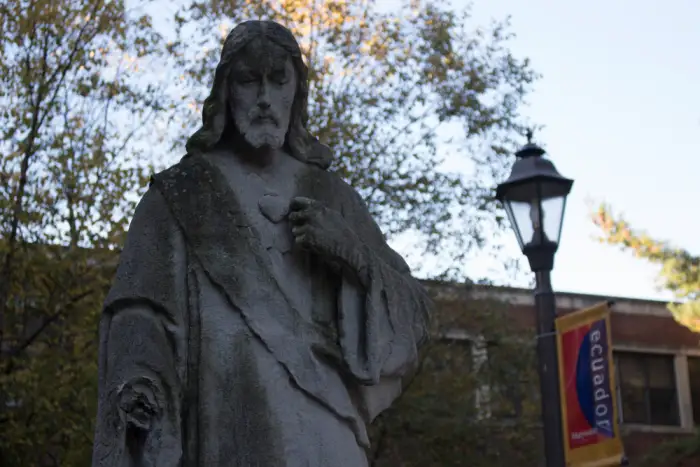
Situated just beyond the Science Center was established in memory of Sr. M. Carmel Gallagher, IHM, and her brother, John Gallagher. (page 26 of A Retrospective).
"On September 18th (1917) a Shrine of the Sacred Heart of Jesus was erected on the seminary grounds. The shrine was built in a picturesque spot not far from the little cemetery that now holds the remains of so many dear ones. This beautiful shrine was the gift of Mr. John Gallagher of Kansas City, brother of Sister M. Carmel. Sister M. Carmel watched its erection with the greatest interest and hoped to live to see it dedicated. Her hopes were not realized. She died on Wednesday, March 14, 1917. ... The shrine now, according to the wish of her brother, is Sister M. Carmel's memorial." (The Sisters of the IHM on page 46)

Through the encouragement of Mother Josepha, a shrine to St. Joseph was erected on the grounds of Marywood (page 57 of A Retrospective). It now stands in a grotto outside the Shields Center for Visual Arts.

Our Lady of Marywood: On December 8, 1936, the Our Lady of Marywood statue was unveiled in the ravine as a gift of the student body to the Dean of the College, Sister Immaculata Gillespie. In 1944, the shrine of Our Lady of Marywood was moved from the ravine and placed on the mezzanine of the Rotunda by the members of the Alumnae Association. (Page 73 of A Retrospective)
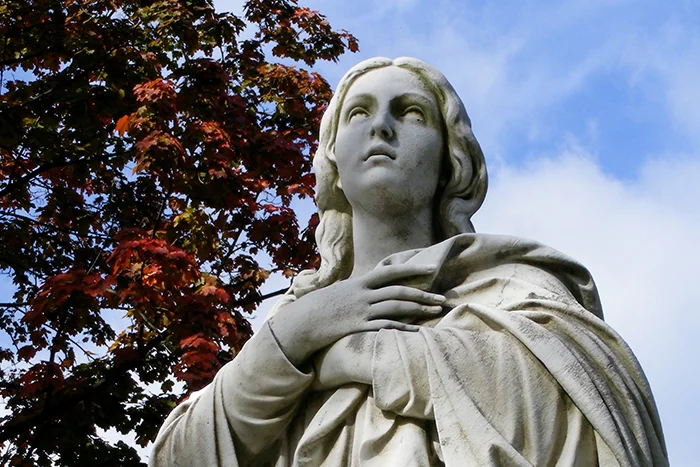
The Student Government donated this statue and it was unveiled in front of Assumption Hall (page 90 of A Retrospective) on December 7, 1954. The Department of Music became housed in a new building named in honor of our Lady's Assumption and erected in the year of the proclamation of the Assumption, 1954.
Most Reverend Bishop Hannan presided at the unveiling of the statue of Our Lady, which was imported from Rome and blessed by the Holy Father, Pope Pius XII, on November 16, 1954. The statue, placed in the front campus, was unveiled with beautiful ceremonies the day before the feast of the Immaculate Conception in the Marian Year. (page 80-81 in So Fair, So Bright by Sister M. Charitas)
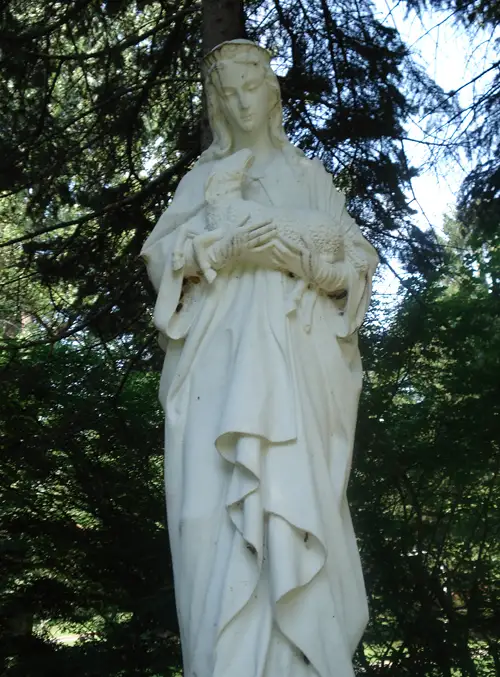
Mother M. Casimir, beloved Mother Superior at the time of her death on February 16, 1929, had realized her desire to provide a home for aged and infirm Sisters through the generosity of Mrs. Agnes Glennon of West Pittston, PA. Mrs. Glennon purchased the beautiful home of W. L. Connell on the Elmhurst Boulevard, Elmhurst, PA, with twenty-five acres of land, barns, caretaker's house, and garage and gave it to Mother Casimir to be used as a convent for infirm Sisters. The new home was named Saint Agnes Place and Sister M. Regis was appointed the first superior there (page 159 of Sisters, Servants, Immaculate Heart of Mary, 1845 -1967).
Mother Casimir's concern for the sisters was also reflected in her love and care of the ill and aging Sisters. The need for a home for these Sisters became known to Mrs. Agnes Allen Glennon, an alumna of St John's Pittston, Pennsylvania, and a close friend of the Sisters, who donated her estate, a beautiful country residence located in Elmhurst, Pennsylvania, for this purpose. As a home for our aged and ill Sisters, it was named St. Agnes Place in honor of the donor. Sister Monica Quinn and Sister John Baptist Hale were sent to prepare the house for occupancy. The work was completed by July 1925, but the house was not opened until early August of that year...Saint Agnes Place was a quiet, peaceful setting on a very productive piece of farmland. There were bountiful supplies of vegetables, a dairy provided milk and butter, and with the chickens a plentiful supply of fresh eggs. In their new surroundings, the Sisters felt only one lack in their new home - the absence of the Blessed Sacrament (page 63 of Sisters, Servants of the Immaculate Heart of Mary, Scranton, Pennsylvania: 1919-1974).
For several years, the community had pondered the need for a better home for our aged and ill Sisters. St Agnes Place, Elmhurst, opened in 1925, in a beautiful site twelve miles from Marywood, was no longer adequate for the growing numbers of Sisters who needed care. Ground was broken at Marywood on October 7, 1954, for a three-story brick building with a chapel wing. It was called Marian Convent, for it was begun in a Marian Year (page 163 of Sisters, Servants, Immaculate Heart of Mary, 1845-1967).
April 9, 1956 - The Marian Convent was completed and dedicated by the Most Reverend Bishop Hannan. One week later, the ill and aged Sisters were transferred from Saint Agnes' Villa, Elmhurst, Pennsylvania, and from the cloister ward of St. Joseph's Hospital in Carbondale. A resident chaplain was secured, and seventy Sisters were enjoying the peaceful and prayerful life of the Marian Convent.
The statue became a part of Marywood's campus after the move. It was temporarily removed from during the construction phase of the Learning Commons (2014-2015). In early 2016, the St. Agnes statue returned to its stand amid the boughs of evergreen trees between the side of the Learning Commons and Nazareth Student Center.

Mother Theophilia, Superior General of the Sisters of St. Casimir, gifted Marywood with a statue of St. Casimir (Information received via email from Sr. Dolores Filicko, IHM, former Registrar and Secretary of Marywood).
Background:
September 26, 1905: Bishop J. W. Shanahan contacted Mother M. Cyril Conway, IHM, and requested that the IHM Sisters provide religious formation for three women from Lithuania;
August 29, 1907: The religious profession of three sisters marked the birth of the Congregation of the Sisters of St. Casimir;
March 14, 1933: Mother M. Josepha Hurley, IHM, assured Mother Maria Kaupas, SSC, that two or more IHM Sisters would teach summer courses in Chicago for the Sisters of St. Casimir. For years, the IHM Sisters provided college coursework leading to a degree from Marywood College for many Sisters of St. Casimir;
June 16, 1933: Mother Maria Kaupas, SSC, and Mother M. Cyril Conway, IHM, received an award from the Lithuanian government, the medallion from the Order of Gediminas, for outstanding performance in civil and public work.
(More information on the Sisters of Casimir can be found on pp. 373 - 381 of The Sisters of IHM)

This statue of St. Alphonsus Liguori, a patron saint of the Congregation of the Sisters, Servants of the Immaculate Heart of Mary, was saved from the burning Motherhouse in 1971 and later put into storage. On November 10, 1994, Reverend Leonard Martin, SJ, then Marywood's chaplain, dedicated the statue on campus on the site of what was, at that time, the Memorial Commons, highlighting the University's celebration of IHM Founders' Day that year. Presently, the statue of St. Alphonsus is located at the entrance of the Motherhouse and Seminary Morgan Memorial Garden, standing as a visual reminder of the spiritual roots of the IHM Congregation and of Marywood itself. The landscape of the garden, created during the University's Centennial Year (2015), is patterned in the footprint of the former Motherhouse and leads to the Learning Commons, also built in 2015.
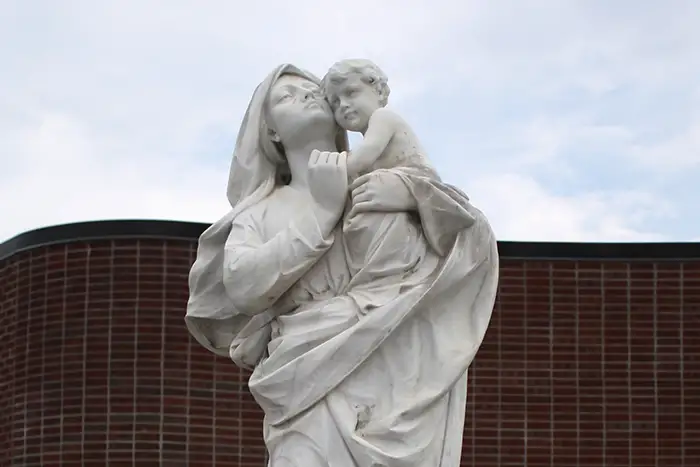
The Blessed Virgin Mary and Child is located outside the Aquatics Center near the tennis courts. The statue was originally displayed in what is now the Admissions Office in the Liberal Arts Building. Years later, it was placed outside the Learning Resources Center which preceded the Learning Commons.

The Seekers, located in the Calabro Delfino Amphitheatre behind the Learning Commons, is a bronze sculpture grouping created by alumna, Professor Emerita, and Former Chair of the Art Department Sister Cor Immaculatum Heffernan, IHM '54. The three life-size sculptures of students represent the power of information technology, social interaction, and cross-disciplinary learning to transmit the wisdom of the past, to assimilate knowledge of the present, and to encourage creative achievement in the future.
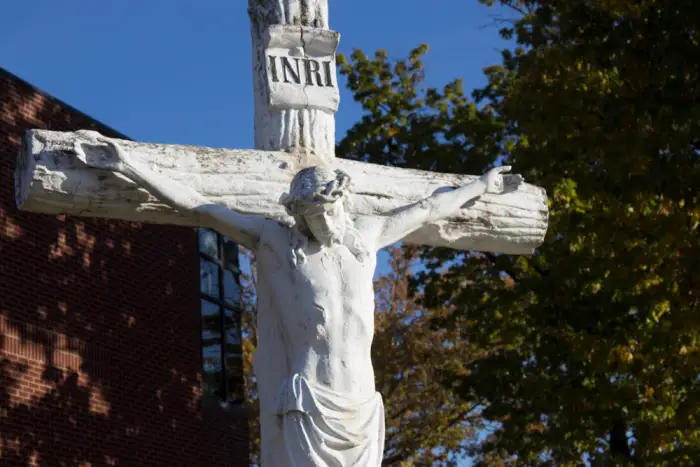
This tribute to deceased IHM Sisters stands on the side of the O'Neill Center for Healthy Families.
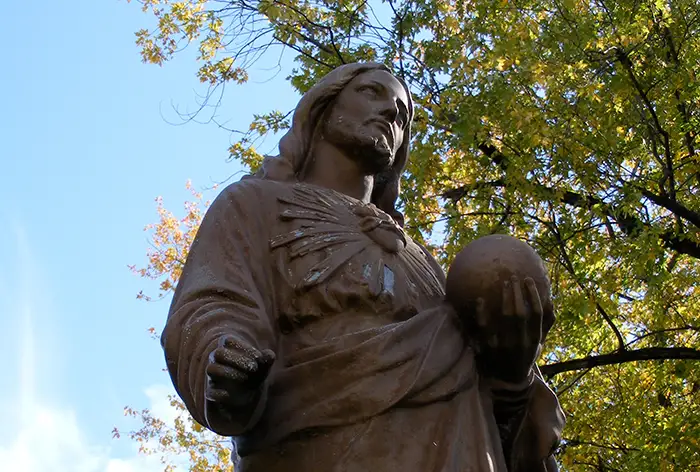
In 1929, this bronze statue of Christ the King was dedicated on campus. It is currently in storage.
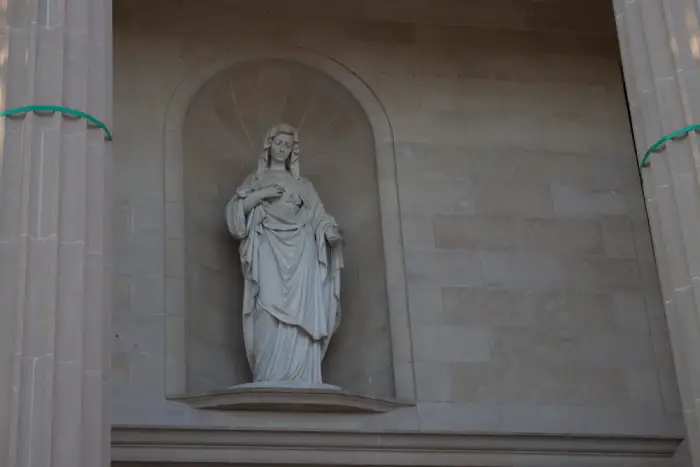
The statue of the Immaculate Heart of Mary stands at the entrance to the Rotunda and Liberal Arts Center. The four panels above the columns are inscribed with the Latin wording for the "Congregation of the Immaculate Heart of Mary"; "Mariae Silva," the name of the University; the Marywood motto, "Sanctitas, Scientia, Sanitas," (Holiness, Knowledge, Health) and the mottos for the state of Pennsylvania and the city of Scranton.
Rotunda Murals
Marywood College was founded in 1915 and chartered under the laws of the state of Pennsylvania as a Catholic College for the higher education of women in 1917. It was the first Catholic college for women in the state. What would become the first college building was constructed between 1900 and 1902. The Congregation of the Sisters, Servants of the Immaculate Heart of Mary, occupied it as the motherhouse of the community, though the foundations of their college work were laid in 1845 when the Sisterhood was formed. In the early 20th century, the Sisters developed the actual foundation of Marywood College that has been the ideal of the institution ever since.
Artistic appreciation is not the least of the abundant fruits of Catholic training. Galleries and exhibits, paintings, etchings, sculpture, music, literature, and all the fine arts are in their true home at Marywood, for it is a well-known fact that Catholic culture is a gracious fostering mother of art. Many treasures were transferred from the Motherhouse when the Liberal Arts building, the first of the college group, was opened. In the 1930s, work was finally completed on the most breathtaking addition to the campus during this period—the Rotunda interior—a task which had been deferred since 1924. Artist Gonippo Raggi was commissioned to paint the murals of the Rotunda. The ambitious effort artistically synthesized the religious and educational mission of the IHM Congregation and of Marywood.
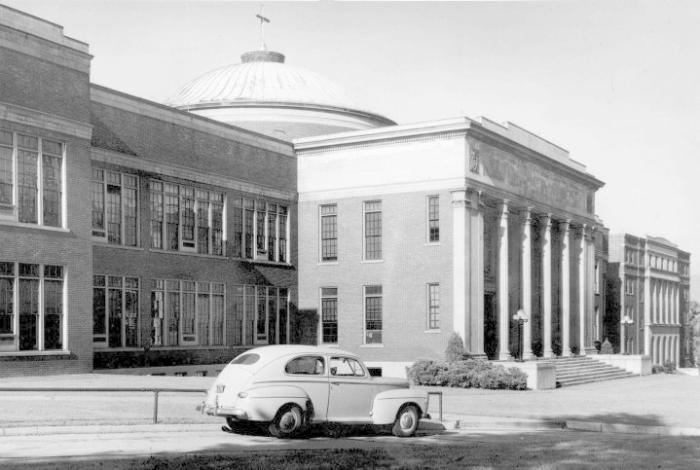
A very large assemblage gathered at the college, March 26, 1924, to witness the formal opening of the arts building. At the entrance to the building, an imposing orthostyle, is an open loggia fronted by four Doric columns. The loggia opens to a large vestibule which in turn admits to a gracious foyer and to the rotunda which in 1937 was a newly decorated gallery, that at the time of opening the arts building was an unrealized dream.
The floor, of which the diameter is 72 feet, 8 feet less than that of the Capitol in Washington, is of blocked Tennessee marble. Pillars of variegated marble support the lofty dome which is adorned with rich golds, deep blues, spring greens and warm, glowing white. A wainscoting of rose-veined Italian marble from the Apennines on both floors and a railing of delicately veined pilasters on the mezzanine floor to match the verde antique marble inlay of the first floor; walls paneled in gold and ivory tones, an exquisitely illuminated and richly intricate scrollwork, make a surprising and admirable color intonation.
The murals,* in the dome and on the walls of both floors, numbering twenty in all, are deeply religious in form and in spirit, the basic idea of the decoration being religion supporting the arts and sciences. Blended ornamental borders, rosettes, Greek key patterns and targets, make a gallery of unsurpassed artistic beauty. The general conception of the decoration was inspired by and based on two fundamental principles for which the religious institute of the Immaculate Heart of Mary was founded; namely, the sanctification of its members and the education and instruction of youth. In the center of the dome, the Holy Ghost is represented symbolizing the faith that is in the community and that inspires, enlightens, and governs its work. A golden halo of sanctity surrounds the symbol.
In the medallion of the library doorway is Pope Leo XIII. In the medallion to the right is Bishop Hoban.
*Professor Gonippo Raggi, K.C.S.G. is the artist of the rotunda.
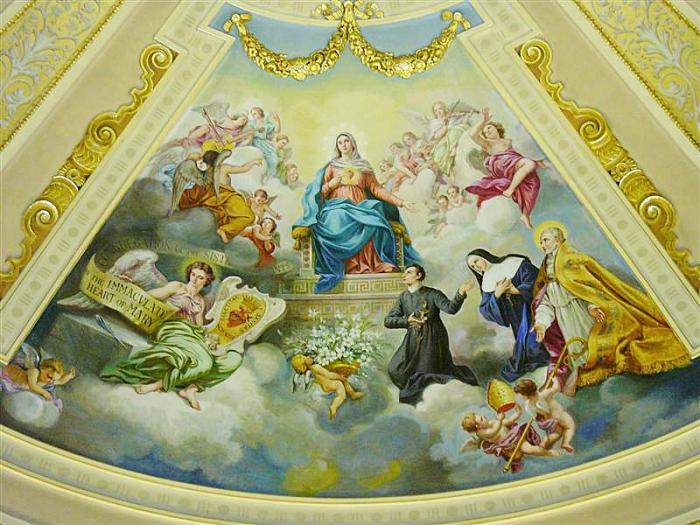
The first in emotional and spiritual appeal of the pictures painted about the central symbol, is that which portrays the Immaculate Heart of Mary, patroness of the Community, represented by the figure of the Blessed Virgin in glory, pointing to Her Immaculate Heart as She is borne by angels and cherubs. Inscriptions and emblems of the Blessed Virgin are worked into the group. Painted beneath is Saint Alphonsus, whose rules are observed in the Congregation. Beside him is the vulnerable figure of Father Louis Gillet, introducing the religious institute co-founded by him and represented in the mural by the kneeling figure of a Sister, Servant of the Immaculate Heart of Mary. This painting is framed by a frieze in colors on a lapis lazuli background with gold, making the tone richer, symbolizing the color of the mantle of the Blessed Virgin and giving the charm of simplicity and contrast to the picture.
The entire coloring gives an effect of freshness and sweetness while there is a delightful exaltation and benignity apparent in the figure of our Blessed Lady as she extends her hand in reception and approval of those instrumental in founding her new Sisterhood of the Immaculate Heart. The cherubs in the picture are a charming creation. Skillfully grouped are the two bands attending our Lady, conveying ideas of the spiritual beauties and harmonies inherent in her sublimity. The cherub at the foot of our Lady's throne holds a basket of lilies; one of the left bears the shield and scroll of the title of the Community, while two cherubs on the right hold the mitre and pastoral staff of St. Alphonsus Ligouri. In the medallion below the mural is our Holy Father, Pope Pius XI, his hand raised in blessing.
An IHM Evening of Prayer Reflection, given on November 10, 2005 (IHM Founders' Day during Marywood's 90th year), by Sister Patricia Ann Matthews, IHM (1940-2008), a revered, longtime Vice President for Academic Affairs at Marywood, stated the following about The Patronal Mural:
"Let me draw you if I may, to the picture from the rotunda on the Marywood University campus. There in the dome is what may be referred to as the patronal mural. You face it directly as you come in the front door of the Liberal Arts Center. The picture shows the Immaculate Heart of Mary enthroned in heaven and 3 people – first, a priest who appears to be presenting a Sister in a blue habit and then a man in a gold cape, a bishop it seems.
The priest is Louis Florent Gillet, a missionary to the U.S. from Belgium, and co-founder of the Congregation of the Sisters, Servants of the Immaculate Heart of Mary, and the sister is any or all IHM Sisters (according to the artist). The other gentleman depicted is Alphonsus Ligouri, a bishop and canonized saint, and founder of the Congregation of the Most Holy Redeemer, popularly called Redemptorists, of which Father Gillet was a member. Father Gillet wanted Sisters to work with him in the mission fields of Michigan (and being unsuccessful in recruiting any to join him), he decided to found a Congregation and got Theresa Maxis (co-founder of the Congregation) to join him in this effort.
As you might expect, Father Gillet passed on the spirituality of his own Congregation, the Redemptorists, to the fledgling IHM group he was mentoring. Later, when Gillet returned to Europe, the Sisters sought out John Neumann, then the bishop of Philadelphia, who was also a Redemptorist, to help them grow in their knowledge and practice of the Redemptorist way, based on the writings, life, and spirit of St. Alphonsus Ligouri. He is the bishop pictured in the Marywood University dome (in one of the episcopal medallions) with Louis Gillet, though they never met and lived in different centuries. Gillet and Bishop Neumann are the connections between the Redemptorist way of life and the newly founded U.S. Congregation of the IHM...Redemptorists came to the U.S. as missionaries in 1832. Father Gillet met Theresa Maxis, and, out of a pressing need, they were inspired to start the IHM Congregation in 1845 in Michigan...We remember these friends of God and we celebrate God's continued blessings on IHM by continuing to tell the story of the Good News – a story of acceptance and blessing, love and inclusiveness, service and solidarity."
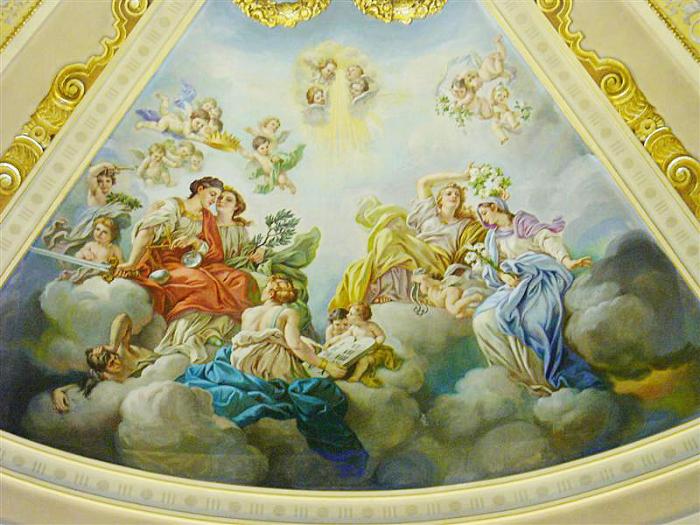
In the panel portrayal of Justice and Chastity, Justice, the central figure, holds her scales of judgment, while, to the left, are dark waters in which an iniquitous figure struggles vigorously but in vain. To the right are tablets of stone, on which are inscribed the Ten Commandments, and beside which is Chastity holding lilies, the gleaming emblems of purity, while an angel crowns her with a lily wreath.
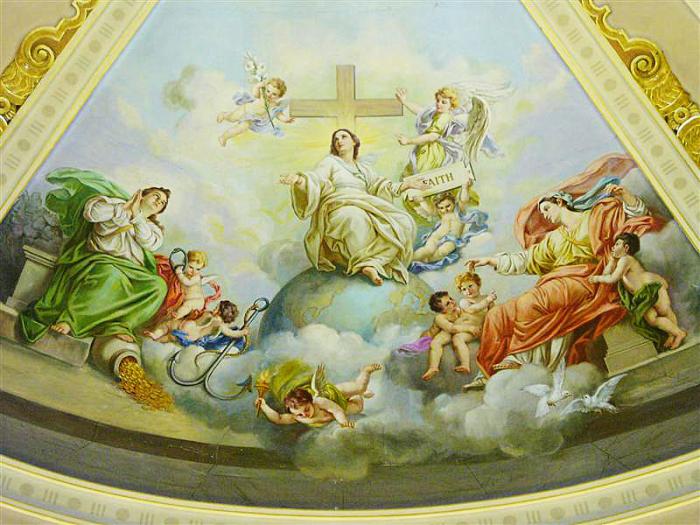
In the dome mural illustrating the triumph of Faith, Hope, and Charity, Faith, the central figure dressed in the white robe of purity, is represented in heaven over the globe to express her divine origin. She is surrounded by cherubs with religious emblems. Charity lovingly cares for little children, as all the classical artists have represented her. Hope sits at the left, garbed in her symbolic color--green, with cherubs holding the anchor, the emblem of her eternal strength. In the foreground is an angel with a flame, the symbol of the eternity of the soul.
This panel is highly symbolic. In a lucid atmosphere of unexpected charm and spontaneity, poetic poses, informed with realism in an admirably decorated renaissance mode, give a lovely quality to the triumph of the theological virtues. While the traditional composition of the figures is retained, the artist has recast them with symmetry into a new mental mood, giving the effect of the last word in the conventional combined with the first in the modern style. The figure in the medallion in the frieze below the mural is that of Pope Pius X.
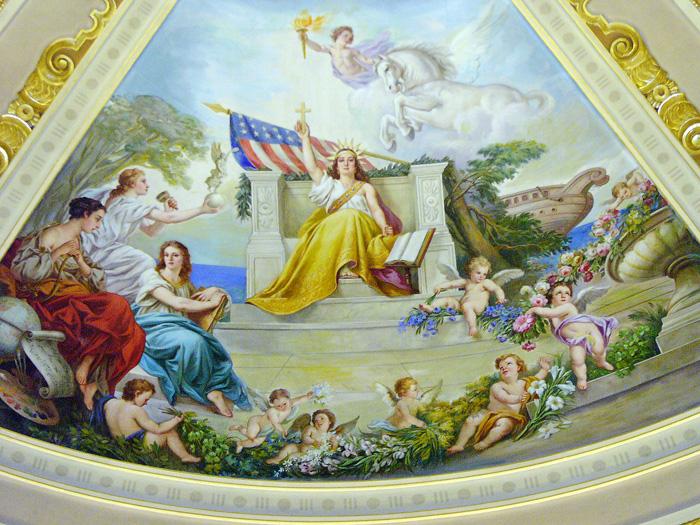
The last of the dome paintings represents Christian Education. The symbol of Christian Education, a young woman, is seated in the center holding a cross and surrounded by religious emblems. The setting behind and to the right—the ocean, the ship, the flag—portray America, where everyone enjoys religious freedom. On the left, the principal arts and sciences are depicted by figures and emblems showing their expansion in the prosperity and liberty of our great nation. Overhead in the background, Progress, a winged horse driven by a cherub, holds the flaming torch of genius. Other cherubs in the lower part of this panel are decorating and entwining flowers that stand for the various nations and nationalities that are to be found in America.
A remarkable color blending gives an enthralling interest to this mural. A fertile, easy, intimate style, an open reach of sky and land, a wealth of detail and classical allusion, make it one of the most effective and beautiful of the murals, symbolizing and synthesizing the religious and secular aims of the college.
In the medallion is Pope Leo XIII.
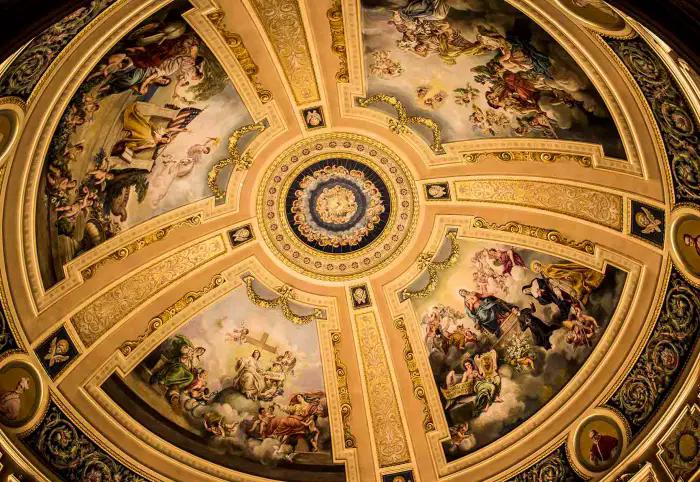
A conventionalized panel among the dome murals is dominated and concluded by cherubs, graceful allegorical figures in low relief. In the medallion frieze beneath each border are busts of the bishops, under whom the Congregation of the Immaculate Heart of Mary came into existence and expanded, beginning with Venerable Bishop John Neumann, who brought the Congregation to Pennsylvania. Portraits of the Popes of the period of the history of the Congregation are painted below the murals. Four popes and four bishops are represented, the bishops besides Bishop Neumann being Bishop O'Hara, Bishop Hoban and Bishop O'Reilly. All these bishops have enriched the Community with spiritual, material, and artistic gifts. Bishop Hoban and Bishop O'Reilly especially have contributed largely to the College, of which the foundation and establishment is due to their wise counsel and spiritual endowments. Their portraits, in the ecclesiastical robes of the bishopric and rose-colored against a gold background, add a note of decorative magnificence in effective contrast to the austere wall space through which the blue, rose, and golden frieze is woven.
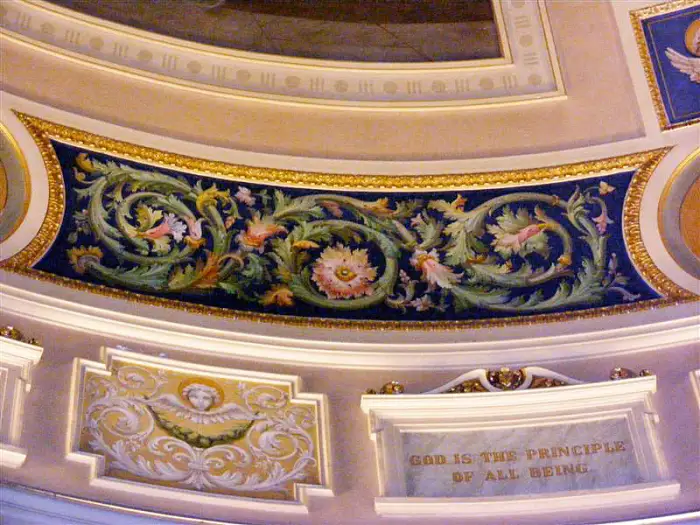
In a circular series below the murals are plaques setting forth utterances of the Sage of the Dominican Order, St. Thomas Aquinas. These artistically framed plaques of green marble are lettered in gold. Inserted alternately with them are ornamental brooches re-echoing the symbolism of the murals. Each plaque bears a complete principle, simple and indubitable. Clockwise about the circle, we read:
- "God is the greatest good"
- "What is of faith cannot be false"
- "Science begets and nourishes faith"
- "All science is derived from self-evident principles"
- "God is the principle of all being"
- "Rational creatures are masters of their own acts"
- "God's Will is the cause of goodness in things"
- "Truth is the equation of thought and thing"
- "All learning results from pre-existing knowledge"
- "To think is the proper operation of man"
- "Grace is more perfect than nature"
- "The formal object of faith is the first Truth"
These basic principles are representative of the education fostered at Marywood.
The coloring of this circle is one of reticent harmonies and cool tones, reserved decoration that affords an agreeable transition to the murals of the mezzanine floor. In the medallions from left to right are Pope Pius X, Bishop O'Reilly, and Pope Pius XI.
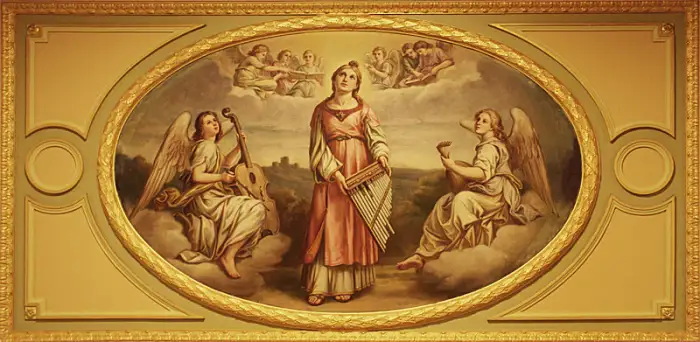
ST. CECILIA - A Roman martyr of the third century, St. Cecilia is the patron of music, portrayed here holding a harmonium and accompanied by angels with cello and lute.
Proceeding to the left from the Lucas Museum of Art, the first of the mezzanine murals is that of Saint Cecilia, presented to the Marywood School of Music, through the generosity of Justine B. Ward, a benefactress and patroness of the school.
A tone of high courtesy and great refinement, even timidity, dominates the picture. The technical argument is simple, the draperies exquisite; there is an absence of detail, a charming subordination, the traditional composition and old motives being retained in all phases of the portrait, but the artistic touch of the Venetian Renaissance also is evident.
Saint Cecilia, Raphael-like, holding a lyre, stands at rest looking up to Heaven in an attitude of listening to the angelic chorus pictured above her. On her left is an angel with a 'cello and on her right an angel with a lute. Harmony exudes from the picture. There is an ease of composition and delicacy of line, a fine balance revealing the essential idea of music, the universal emotional language in the classic tradition and yet transcending it.
Saint Cecilia has been proclaimed Queen of Harmony because her life was one melodious song in the midst of the greatest trials. Her abandonment to God and her boundless confidence in Him was so great that they enabled her to make souls pure that had sought only earthly pleasures. The "Book of the Holy Gospels lay ever on her heart." In the evening of her wedding day, with the music of the marriage hymn ringing in her ears, She, a rich, noble, beautiful Roman maiden, renewed her vow of virginity to God. Her young husband, Valerian, and his brother, Tibertius, were so moved by her Consecration, that like her they devoted themselves to Christian ideals of perfection, and all three had their offerings crowned with martyrdom. In the second century after Christ, these three young martyrs were united to Him, having pledged their love for His teaching with suffering and with death.
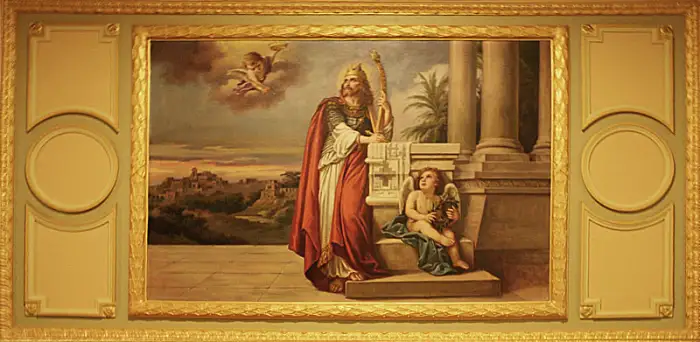
ST. DAVID - Another patron of musical art, King David is shown writing his psalms while holding a harp. The combination of instrument and written text endow the scene as a evocation of choral music.
Next to the mural depicting Saint Cecilia the patroness of Music, is that of another divine singer, the psalmist David, accompanied by an angel bearing a laurel crown, the symbol of poetic genius. Crowned as the second King of Israel, as a psalmist, as a prophet, as a type of the Messias, the great-grandson of Boaz and Ruth and the youngest of eight sons of Jesse, the noble root whence the Lily of Israel blossomed, David, her illustrious ancestor, like her Divine Son was born at Bethlehem. Of David's life and character, we know from the Scriptures that he walked in the ways of the Lord and kept His Commandments, and the Lord of Hosts was with him; that he reigned forty years over Israel; that he played his harp for the refreshment of Saul; that his son, Solomon, succeeded him; that he fought with the Philistines; that he encouraged the people to contribute to the building of the Temple, since it was for the service of the Lord. Many other things David did, but no accomplishment excelled in sublimity his psalms.
David is a facile invention with a lucid ordering of elements from his actual life; his own figure, the symbols of things which he exemplifies, the mountain distance, the sky, the holy city, all are invested with a gracious play of mass and line and color and reverent sentiment. It is an unforgettable portrait of David, the unforgettable singer of thousands of beautiful and poetical lines. Never have there been any lines of poetry like the timeless, melodious, rhythmic, lyrical, sheerly beautiful lines of the familiar psalms. Daily we have said on our knees before the Crucifix, with David the prophet: "They have pierced my Hands and Feet, they have numbered all my bones." Hymns of praise and adoration, songs of sorrow for sin, psalms to the majesty and glory of God, paeans of joy that rival those of the "lark that sings at heaven's gate" make an incomparable anthology of lyric poetry that we know as "The Psalms of David." With Moses and Isaiah, he has stood as the grandest of the prophets of Israel.
The mural of David is one of ideal beauty, astounding youth in alert pose, a Biblical David yet a forceful and vigorous young man playing a harp. It is touched with imaginative power with an inspired, a free, a suave, a broad, and a majestic presence. There is a suggestion of the romantic with dignity and intelligent feeling in this agreeably and originally painted composition, compelling, picturesque, and distinctive, very definite in detail, full of meaning and variety, of quiet tone color, transfigured with the glory of life itself.
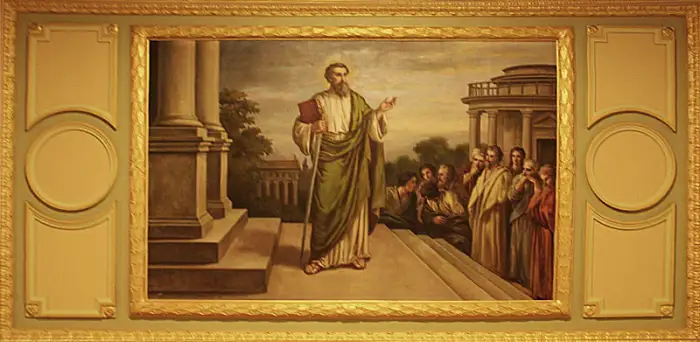
ST. PAUL - Oratory is represented by St. Paul, the eloquent preacher, seen here delivering a sermon at Athens. The Apostle to the Gentiles thus spreads the word through persuasive speech.
In the mural next to David is that of the great apostle Saint Paul, as the patron of oratory. From the time of his conversion at Damascus, Paul preached so eloquently in the synagogues and before university audiences such as that at Athens, his own Alma Mater, where he is depicted in this mural, that he became one of God's principal instruments in the Christianizing of the world. Born at Tarsus and qualified to great distinction and exemptions by virtue of his privileges as a Roman citizen, he was well instructed by his teacher, Gamaliel, by whom, as well as at the university, he was enlightened in the strict Old Law. He was especially gifted with new sight and new light from the Holy Spirit at the time he became a Christian convert.
With Saint Peter, he consecrated the new holy city, Rome, with his martyrdom. He wrote fourteen Epistles, a fountainhead of Church doctrine, in which his interior life lies open, but he preached valiantly like a chivalrous knight and took captive every thought of his audience to the obedience of Christ. Through Saint Luke in the Acts of the Apostles, we see Paul's hopes, his plans, his amazingly multiplied communities of Christian congregations. As soon as he laid the foundation of the faith, he left the care of the new flock to a local ministry while he went on to fresh fields, returning from time to time to revisit and confirm his congregations. We learn from the Acts that Paul traveled over land and sea, the length and breadth of Asia Minor and on to Rome preaching, teaching, and writing—to governors, to philosophers, to tradesmen and to simple people—but "to not many wise, not many noble, not many mighty." He preached at Antioch, Ionius, Lysbia, Derbe, Troas, Ephesus, Phillippi, Thessalonica, Bares, Athens, Corinth and elsewhere, all the while from refined and elegant cities along the Aegean and the Mediterranean enrolling thousands under the standard of Christ. In his plan for radiating Christian doctrine, he astounded his generation by giving place to womanhood. His first European convert was Lydia, a young woman, a seller of the famous Tyrian purple. Phoebe carried his most important epistle on charity to the Corinthians.
A highly cultured attitude of mind, a profound genius for assimilating religious truth, an abundance of supernatural gifts, marked many of the audiences where Paul brought the initial impetus of Christianity and the great Commandment of the new law, so that all human beings, women as well as men, and every sphere of human activity was included in his plan of universal brotherhood in Christ.
In his discourse to the Athenians, as depicted in the Marywood mural, we catch a reflection of the high culture which informs the audience. We see various character studies of men. Their serious aspects are distinct and objective, their dignity classic. The essential originality of Paul's career, his charity, and his vehement zeal are portrayed with care and superb technique, while the great preacher, standing forth like a pedimental figure, makes this a fine specimen of mural design.
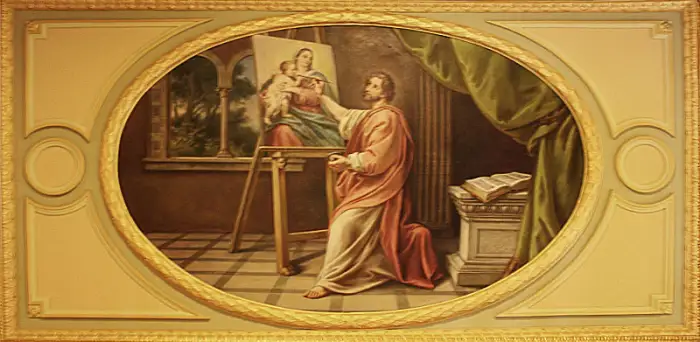
ST. LUKE - A convert of Paul, the Greek physician St. Luke was also a painter, thus depicted as patron of the visual arts. Here he paints the Virgin and Child, said by tradition to remain today as the icon of Our Lady of Czestochowa, the Black Madonna of Poland.
St. Luke, a convert of St. Paul, was a physician of Antioch and a painter, and he has been chosen to represent the student artists of Marywood in the Rotunda mural decoration. He is best known as one of the historians of the New Testament. From the Acts of the Apostles we learn that St. Luke sailed with the Apostle to the Gentiles from Troas to Macedonia; that he was with him at Philippi and in the shipwreck and perils of the memorable voyage to Rome. St. Luke died at Achaia.
The visualization of the physician-painter in his studio at work at his easel is simple, yet remarkably dramatic. The utter simplicity of the design is given greater meaning and force by the awe and reverence and exaltation beyond himself in the painter's pose; in the unobtrusive, orderly background, but especially in the connotation of the relationship between our Lady and her Divine Child and the Evangelist. Must he not have received from her own lips much of the "verity of those words" in which he was instructed? Of the Annunciation? Of the announcement of the birth of St. John the Baptist? Of the Visitation? Of the Birth of Jesus? Of many of the messages and mysteries which he narrates?
The painting is posed with vigorous realism, yet is naive and delightful, with classic detail, engaging pictorial representation, an unusual vision of a perennially beautiful subject, the Madonna and Child, in all a perfect grouping and coloring. The mural of the evangelist-painter is as striking as it is original and impressive.
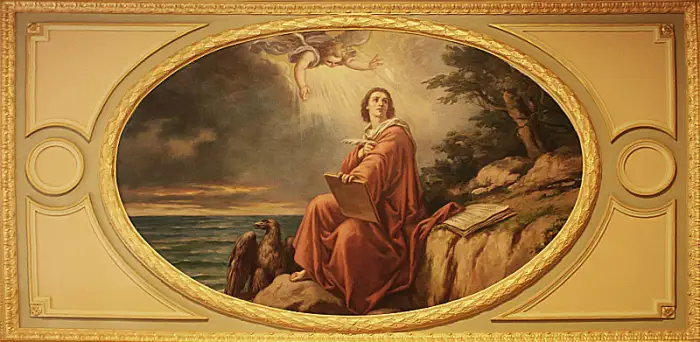
ST. JOHN THE EVANGELIST - St. John is deemed patron of literature because of his artistic rendering of the Gospel, his epistles, and the masterpiece of the Book of Revelations. His symbol, the eagle, is shown beside him as an image of strength and keenness of vision.
St. John the Evangelist, chosen to be the patron of literature in the mural pictures, was a disciple of St. John the Baptist and was called by Christ to be His "beloved disciple."
The beloved disciple witnessed the raising of Jairus' daughter; the Transfiguration; he was sent with Peter to make preparations for the Last Supper; he witnessed the Agony in the Garden, arid he stood, alone of all the disciples, with our Blessed Mother at the foot of the Cross. His place at the Last Supper was next to Christ. His privilege it was to lean his head on the Master's bosom. He received our Blessed Mother as a son in the name of all mankind. He was the first after the Resurrection to hasten with Peter to the grave of our Saviour. He recognized our Blessed Redeemer after the Resurrection at the Lake of Genesareth. After the Ascension and the Descent of the Holy Ghost, he took part with our Blessed Lady and Saint Peter in caring for the Church.
St. John wrote sublime epistles for the early Christians, and, after years in Palestine and beyond, was exiled to the island of Patmos "for the word of God and the testimony of Jesus" where he was honored with the heavenly revelation contained in the Apocalypse. The beloved Apostle in his prologue to his gospel story of Christ outlines in a few sentences, the divine generation of the Word and the divine tragedy of the Messias; such sentences as "In the beginning was the Word and the Word was with God and the Word was God." "He came unto His own and His own received Him not, but as many as received Him, He gave them power to be made the sons of God"; "And the Word was made Flesh and dwelt amongst us." In the mural, we see St. John at Patmos receiving Angelic inspiration.
The royal eagle is a fitting symbol for Saint John the Evangelist, for the eagle is known for grace, strength, keenness of vision, and powers of flight above all creatures, as Saint John the Evangelist is sublime among all stylists, even the most royal of scriptural stylists, soaring to heaven itself to open his grand profession of faith in his gospel concerning the Eternal God, Creator and Redeemer.
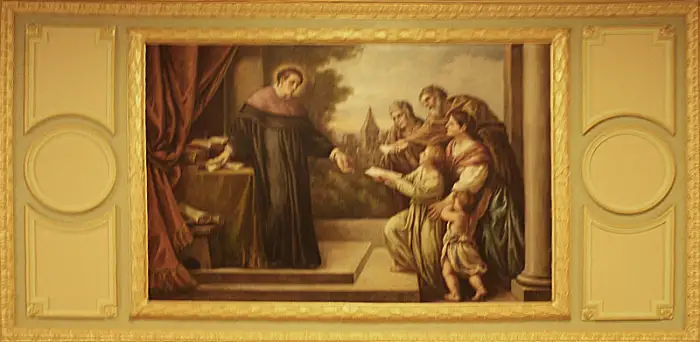
ST. IVES - Relatively unknown, St. Ives was a 13th century French lawyer, and thus the patron of attorneys and students of law. He gained renown especially as an advocate and lawyer for the poor.
St. Ives was the "Ideal of the legal profession" and the "Patron Saint of attorneys". In the murals, he represents law. He had a universal sense of justice, law, and peace. Frontiers created by man cannot limit the radiancy of such a soul.
St. Ives was born at Kermartin, Brittany, October 17, 1253; he died at Louannec, May 19, 1303. In 1267, Ives was sent to the University of Paris, where he graduated in civil law. He practiced law at Rennes and Treguier, and later joined the Franciscan Tertiaries. Ordained in 1284, he was appointed to the parish of Tredrez and later to Louannec, where he served as bishops' judge and lawyer of the poor. By this great zeal and rectitude in the discharge of his duties, and by his great charity, he gained the title of advocate and patron of the poor. He was buried in Treguier and was canonized in 1347 by Clement VI, his feast being kept on May 19.
His relics are at Treguier. In the rotunda panel, he is shown with his poor clients, in a legal setting and wearing the robes of a doctor of laws, he extends himself benignly, and charitably receives the petitions eagerly presented to him; even children, as well as their elders, being unafraid to approach their kind benefactor. An accomplished technique as well as tender and lonely conception, characterize this mural.
He is just, refined, and vital with good spatial distribution, a picturesque vein, and a quiet medieval landscape in the background.
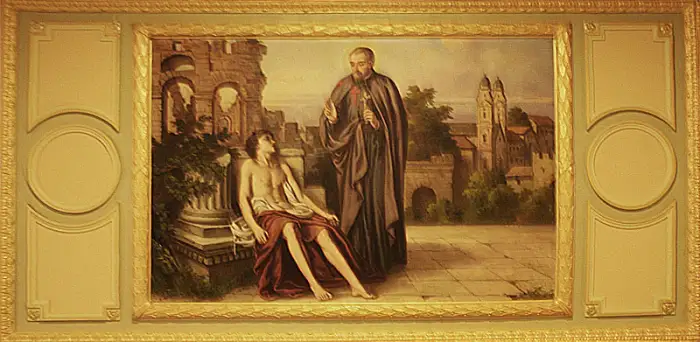
ST. CAMILLUS - Another little-known saint is presented as patron of medical science and the nursing profession. A 16th century Italian soldier, and himself afflicted with life-long illnesses, St. Camillus became a nurse and later a priest, founding first an order of lay infirmarians and then the Fathers of a Good Death. His spiritual director was the great St. Philip Neri.
Camillus de Lellis, born in Naples in 1550, served as a Venetian soldier. When he suffered from abscesses, he obtained employment with the Hospital for Incurables in Rome in the hope of obtaining hospital care. Later, he was employed by Capuchins at Manfredonia in a hospital they were building. He was admitted as a lay brother to the order, but was dismissed on account of his infirmity. He then became a nurse in a hospital in Rome where, through piety and prudence, he became director of the hospital and founded an order of lay infirmarians. St. Philip Neri was his spiritual director. Camillus became a priest and founded an order of Fathers of a Good Death. He bound the members of the order by vow to devote themselves to the plague-stricken and to the care of the sick in their homes. Pope Sixtus V confirmed the congregation. In 1591, Gregory XIV erected the society into a religious congregation with the privileges of mendicants. For 46 years, Camillus suffered, but he was not deterred thereby from establishing mercy houses in many parts of Italy. He was canonized by Benedict XIV in 1746.
In the mural, which is dedicated to him as the patron of medicine, we see Camillus, clothed in the habit of his order administering the final absolution to a dying young man. Reclining on a ruined portal, the youth in extreme desolation and abandonment, is a wasted victim of one of the plagues which ravaged Italy during the lifetime of Camillus. The saint fearlessly and pityingly approaches to prepare the youth for his journey to Eternity. The figures of the boy and the saint dominate one side of the picture while in the background on the other side is a noble city. The picture is a fine example of the massing of light and color, a well-balanced and a well-blended scene, with no exotic or fantastic motifs but a calm picturing of disease and death, relieved by Christian Charity and spiritual consolation.
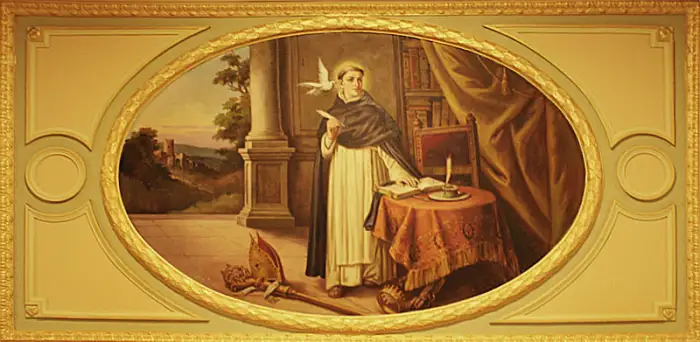
ST. THOMAS AQUINAS - Philosophy, the queen of the Liberal Arts, is represented by the 13th century Thomas of Aquino, in Italy, portrayed in his Dominican habit. His many philosophical treatises, sampled in the plaques beneath the dome paintings, still form the foundation for Christian doctrine.
In this last of the 20 murals, St. Thomas is depicted with the dove of the Holy spirit at his ear, an image of divine inspiration. This is a popular view of Aquinas, since only the Bible is accepted as literally inspired. However, the image is quite appropriate as a final commentary on the creation of Gonippo Raggi.
The Angelic Doctor, the patron of philosophy and Catholic students in their quest for the knowledge of causes and effects, was himself a pupil of St. Albertus Magnus and, later, a professor of philosophy and theology at the University of Paris. Though born at Aquino in Italy in 1226, and at the age of 19 clothed in the Dominican habit at Naples, his influence went far beyond his native land. The Church venerates his numerous writings as a treasury of Christian Doctrine. His science is more divine than human. Prayer, he said, taught him more than study; and his piety surpassed the genius of his intellect. His Blessed Sacrament and Corpus Christi hymns are used and known everywhere, as is the story of the miraculous Crucifix at Naples. To the words of our Crucified Saviour to Thomas, "Well, hast thou written concerning Me, Thomas. What shall I give thee as a reward?", Thomas replied, "Naught save Thyself, O Lord."
The mural is full of the symbolism of inspiration. The open book, the pen, the saint's attitude of listening to the Holy Spirit, the discarded crown, and the mitre and staff of the bishopric, the angelic countenance of the Saint of the "Summa", his books, his study, withdrawn from the attractive world beyond, all these and other details are carefully depicted, the subsidiary supporting motifs enhancing the main composition, and the contemplating mood of the picture; its noble aim, its compelling style, its gracious rhythm, its mingling of inner and outer conditions of life, free, strong, glowing in both the natural and the spiritual order with the spiritual given proper predominance, leave the final impression of a ripened, reflective spirit within, a bright serene sky and landscape without, with the angelic scholar as fitted to both environments as a lark is to the environment of a morning in May.
Wall Murals
The 16 Rotunda wall paintings, framed in sculptured ornamental borders, are arranged in two groupings. Faith, Hope, Charity and the Cardinal virtues of Prudence, Justice, Fortitude, and, Temperance. The eighth panel, the Good Shepherd, represents Christ as the culmination of all the virtues.
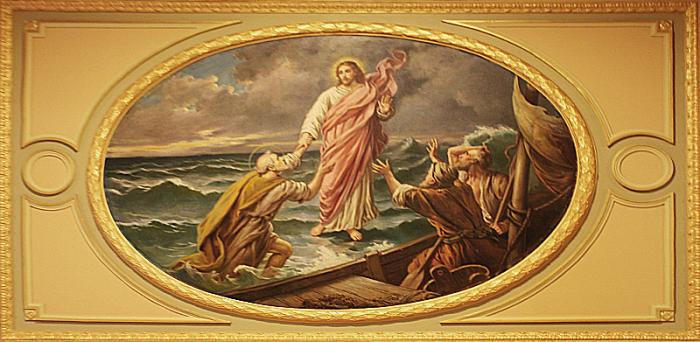
FAITH is characterized by the figure of Jesus walking on the water near a sinking Peter whose faith has failed him.
The panels on the main floor represent the theological virtues, Faith, Hope, and Charity and the cardinal virtues, Prudence, Justice, Fortitude, and Temperance. The final panel The Good Shepherd, completing the epitome of the virtues depicted, shows the zeal of religion for the irreligious as exemplified in the parable of the divine Shepherd.
In the panel representing Faith, the scene chosen is that of Christ stilling the Tempest and taking the hand of St. Peter to give him confidence in the protection of our Saviour. The fishermen and the disciples are portrayed as lifting their arms in supplication: "Lord, save us, we perish". Their boat is a type of the Church assailed by storm but weathering it safely because our Lord in the hour of greatest danger commands the storm: "Peace, be still!"
But the boat in the midst of the sea was tossed with the waves: for the wind was contrary.
And in the fourth watch of the night, He came to them walking upon the sea.
And they, seeing Him walking upon the sea, were troubled, saying: "It is an apparition." And they cried out for fear.
And immediately Jesus spoke to them, saying: "Be of good heart; it is I, fear ye not."
And Peter making answer, said: "Lord, if it be thou, bid me come to thee upon the waters."
And He said: "Come." And Peter, going down out of the boat, walked upon the water to come to Jesus.
But seeing the wind strong, he was afraid: and when he began to sink, he cried out, saying:
"Lord, save me."
And immediately Jesus stretching forth his hand, took hold of him, and said to him: O thou of little faith, why didst thou doubt?"
And when they were come up into the boat, the wind ceased.
And they that were in the boat came and adored Him, saying: "Indeed thou art the Son of God."
There is a touch of mystery and supernatural calm in the mural, such as would have followed the instant abatement of the storm, contrary to the natural manner of gradual subsiding of the elements. The coloring is rich, the line and landscape lovely, the movement flexible, the form serious, yet infused with a seemingly miraculous character.
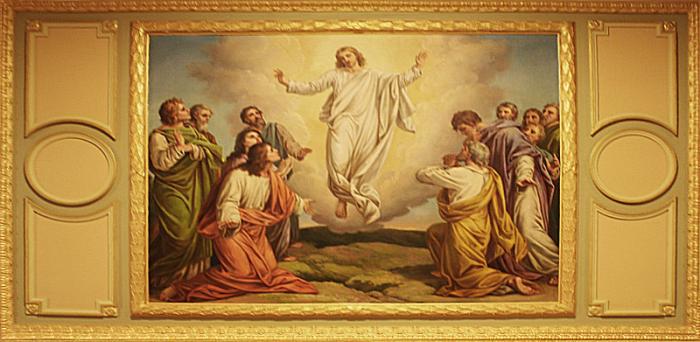
HOPE is seen in the portrait of a radiant Jesus appearing to the remaining eleven apostles after the resurrection.
The panel representing hope is a picture of our Risen Lord. Resplendent and bright, our Saviour came forth from the closed grave and appeared to the Apostles who are grouped on either side in Galilee, with our Risen Lord in the center above them. The scene is the second stage of the Resurrection drama, the three women having conveyed the news of the resurrection to the Apostles who, in apparent wonder and admiration, gaze devoutly at their Risen Master. The picture has unusual grace and charm and is filled with dramatic character as well as expressive of hope in our own future resurrection, and our rising now from sin and sorrow to a new life of joy and gladness walking in the way of the disciples of Christ, in His glorious triumph and His victory over death.
The force and energy and feeling for splendor necessary to such a subject as this portrayal is a grandly impressive characteristic of this mural. While very vivid and colorful it is also cool and soothing as hope itself, and is as clear, deep, and satisfying, as the contemplation of the subject which it depicts. The treatment of landscape, light, and atmosphere play no small part in the achievement of these effects, and the general harmony of intention and execution give direct pleasure to the eye, and act like music on the mood, stimulating hope in the thought and memory of a now familiar and most beloved mystery.
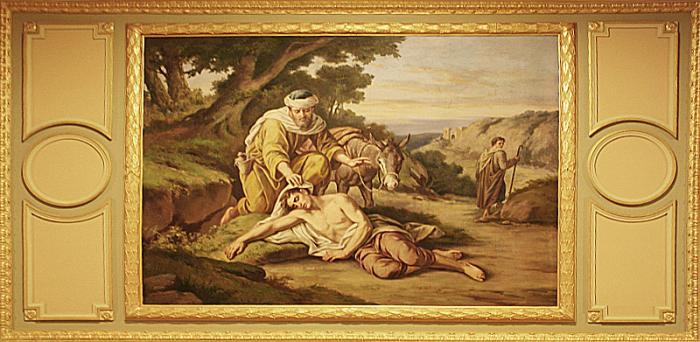
CHARITY shows the "first social worker" in the person of the Good Samaritan.
The most important duty of brotherly love, the great commandment of the new testament, is emphasized in the portrayal of Charity in the parable of the Good Samaritan which follows immediately the painting of hope as depicted in the Resurrection. Replying to the lawyer sent by the Pharisees to question Him, our Saviour answered, "What is written in the law? How readest thou?" and the young man, answering, said: "Thou shalt love the Lord thy God with thy whole heart and with thy whole soul and with all thy strength, and with all thy mind, and thy neighbor as thyself."
But willing to justify himself he said to Jesus: "And who is my neighbor?"
Our Saviour answered him with the beautiful parable of the Good Samaritan, showing that the way to eternal life is Charity, and the chief commandment is the love of God and of our neighbor. In the Good Samaritan is exemplified the first social worker of the Christian era.
The scene depicts the oppressive loneliness of the wayfarer who had fallen among robbers, deprived of everything, wounded, and lying half dead on a rock by the wayside. At a turn in the road, the Levite, having failed to succor the poor traveler, looks back to see the Samaritan bending over him. The Samaritan's beast stands ready to receive the wounded man. Compassion is reflected in the very atmosphere of this part of the painting, even a shaded spot under a tree nearby lending relief to the desolate road winding towards Jericho.
The priest had already passed that way, but neither the priest nor the Levite freed himself from self-love and self-interest long enough to show mercy to the distressed man. The charity of the Samaritan, however, is striking. He forgets himself on behalf of a stranger and sacrifices his own comfort and property to aid him, promising to do more in future and that for a person who considered him an enemy and an inferior.
This picture is interesting both in incident and in detail, exemplifying in scene and in psychology, a composition full of meaning and variety. The charm of kindness and a delicate feeling for the simple effects of light and shade and color; the popularity of the episode, the loneliness of the scene, the democratic idea it conveys, as well as the original place, Bethpage, and the occasion of its actual happening, a more than human purpose, as well as a Christ-like devotion to the needs of men, a feeling of contempt for those who neglect or refuse to assist such needs, all these things bespeak the reasons for the appreciation which this mural commands.
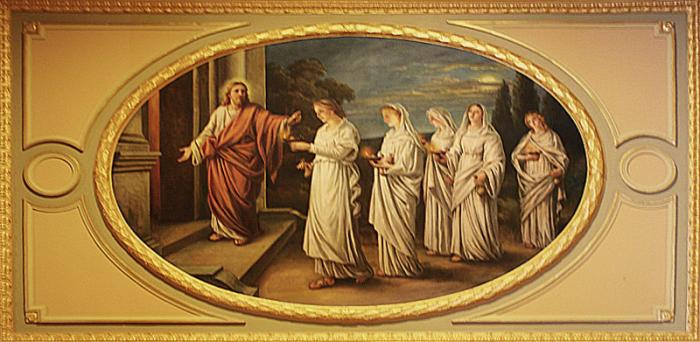
PRUDENCE is exemplified by the five wise virgins bearing torches as symbols of the light of faith and the lamp of learning.
In the panel depicting prudence we have a lovely scene of five wise virgins described by St. Matthew in Chapter 25 of his Gospel, wherein the parable of the ten virgins shows five foolish and five wise. The latter, more prudent than the former improvident virgins, filled their lamps with oil while awaiting the coming of the Master. The parable is often used as an example of those who enter religious life in answer to the divine call, but the parabolic form of teaching as it is conveyed in this gospel usually has a more widespread application; and exemplifies herein those souls who diligently prepare for eternal life by vigilantly awaiting their call. Holding their lamps burning in their hands, as the wise virgins are doing, and carrying a vial, the symbol of charity and of prayer, wherewith to replenish their lamps with oil, they receive the graces necessary for their journey through this life because of their continuance in prayer and good works.
The scene depicted in the mural shows the arrival of the Master during the night, and the call of the maidens to enter the heavenly kingdom because their lamps were kept burning and there was no delay in opening the doors immediately when He came, for the virgins were faithful in the service of God. Besides being full of religious significance, graceful and finished, the picture holds the ethereal charm of young maidenhood enhanced by the delicacy of an exotic, moonlit night. Simple, reticent, sensitively precise, yet graphic and illuminated, the figures are set against an exquisite background. The details are so interwoven as to create an impression of intense spiritual beauty, interpenetrated by a fresh, vivid outdoor tone, with contrasting notes so graciously and serenely mingled as to imply a feeling of expectation of the beauty that is beyond and subsequent to the scene before us.
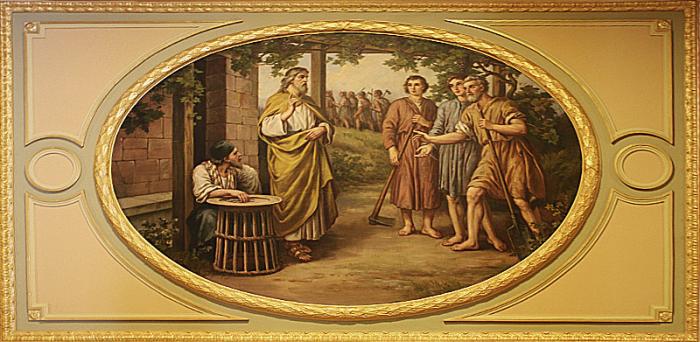
JUSTICE is seen in the mural of the workers from the vineyard awaiting wages they had agreed to accept.
The panel portraying Justice has the theme of the parable of the laborers in the Vineyard, from Saint Matthew's Gospel, Chapter 20:1-16. While the parable consists of two chief points, namely the calling of the laborers and their payment, the story emphasized in the Rotunda portrayal is that of the payment of the laborers. A beautiful vineyard in the Holy Land is the scene and the time is spring. There was much work to be done, and the laborers were few, so, later in the day, others had to be found who would assist with the vines. The paying agreement which the householder made with the latter was, "I will give you what shall be just."
Evening came, and the picture shows the moment when those last hired had received their pay and passing out of the vineyard, turned to look back at those who had been hired first, arguing with the master: "These last have worked but one hour, and thou hast made them equal to us, that have borne the burden of the day and the heats."
And the answer of the steward "I do thee no wrong—Did I not agree with thee for a penny? Take what is thine and go thy way." The parable of Justice, the chief thought represented in the picture in allegorical significance, is deeply impressed on the beholder—death, the evening of life, the distribution of graces, the glory of heaven, the merits of individuals: the truths of many religious doctrines thus conveyed. The elemental beauty of the earth and its enveloping atmosphere is admirably expressed. The picture is palpitating with life in subtle earth tones of browns, purples, yellows, and deep greens. There is a very poetical character besides in this transcript of a vineyard scene, composed in tone, and with an artistically important feeling of the value of space and air and landscape as well as of expressive figure composition; in a word, this mural synthesizes tone, form, and light, with energy, strength and splendid style.
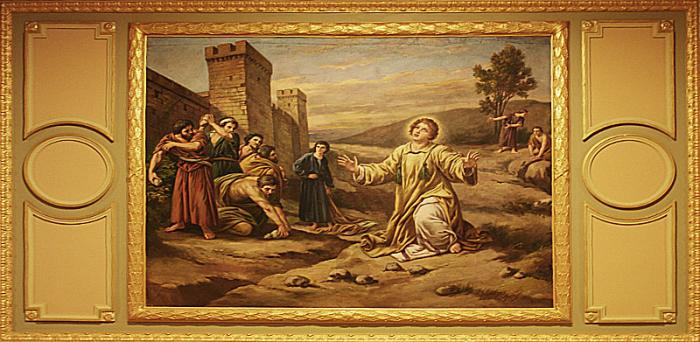
FORTITUDE is dramatized in the painting of St. Stephen suffering martyrdom by stoning.
The First Martyr
St. Stephen, one of the 72 disciples of our Saviour, was chosen after His Ascension one of the seven deacons. Their ministry was very fruitful, but Stephen especially, full of grace and fortitude, did great wonders and signs among the people. Many adversaries rose up against him, but they were not able to withstand the wisdom and the spirit that spoke through him. At length, he was brought before the Sanhedrin and charged like our Divine Master with blasphemy against Moses and against God. Stephen boldly upbraided the chief priests for their resistance to the Holy Ghost and for the Crucifixion of the Saviour. They were so angered they gnashed their teeth against him and ordered him to be dragged outside the city where he was stoned to death, thus becoming the first Christian martyr. In the mural we see the scene of his martyrdom, Stephen looking up to Heaven as though filled with the Holy Ghost and seeing the vision in which he declared: "Behold, I see the Heavens opened and the Son of Man standing at the right hand of God".
The Jews are holding stones to throw at him, while Saul, at one side, keeps their garments.
This mural expressing fortitude seems to be composed in tone rather than in form, though the effect of the battlements, the hill country, the resentment depicted on the wrathful faces of his executioners, the joyful countenance of Stephen, the elemental beauty of the enveloping atmosphere subtly suggesting earth tones, but palpitating with spiritual life as they surround the martyr, give a sense of terrible beauty and sheer truth to the picture that appropriately associates it with an ideal of Fortitude.
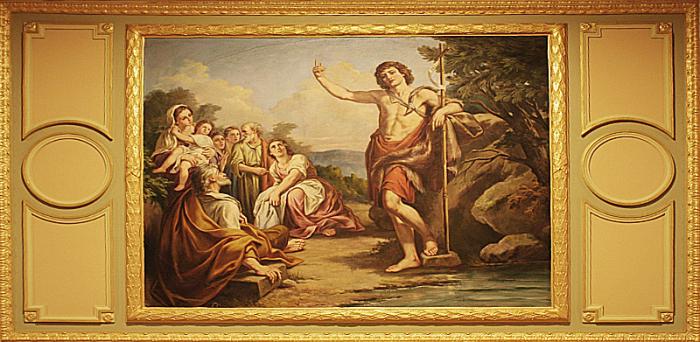
TEMPERANCE is seen in St. John the Baptist doing penance for past excesses and failings.
St. John the Baptist
And it came to pass when he executed his priestly function-there appeared to him an angel of the Lord—who said to him, "Fear not, Zachary, for thy prayer is heard and thy wife Elizabeth shall bear thee a son, and thou shalt call his name John;—and many shall rejoice in his nativity. For he shall be great before the Lord; and shall drink no wine nor strong drink; and he shall be filled with the Holy Ghost even from his mother's womb. And he shall convert many of the children of Israel to the Lord, their God. And he shall go before him in the spirit and the power of Elias; that he may turn the hearts of the fathers unto the children, and the incredulous to the wisdom of the just, to prepare unto the Lord a perfect people."
This angelic prophecy to Zachary describes his son, St. John the Baptist.
In the mural we see him as the Forerunner of the Messias, preparing His way among the Israelites. The precursor is wearing his garment of camel's hair and a leathern girdle about his loins. He had come from the desert for his manifestation to Israel into the country about the Jordan, preaching the baptism of penance for the remission of sins. While he worked no miracles, he suffered martyrdom, for Herod had him put to death, by beheading, because he reproached the tetrach for the evils he had done.
St. John is here depicted as enlightening them that sit in darkness and in the shadow of death, directing them into the way of peace with the voice of one crying in the wilderness: Prepare ye the way of the Lord, make straight His paths. For behold, the Messias shall come after me "the latchet of whose shoe I am not worthy to loose." St. John was beloved for himself, but he realized that he grew and was strengthened in spirit for one glorious mission only, a special divine mission of baptizing with water and preaching austerity, prayer, and penance in preparation for the coming of the Saviour.
Though penance is the ideal depicted in the mural, and while strength and the spirit of temperance abound in its character, there is something, too, of a song of spring, in an exquisite design of lines and spaces conveyed by the branches, the rivulet, the faces of youth, the tender coloring, the sweet asceticism of the young saint and the old men turning to him or to the children. In this mural, we are close to perfect beauty, in a dematerialized region where thought and feeling seem brought to life without tangible means.
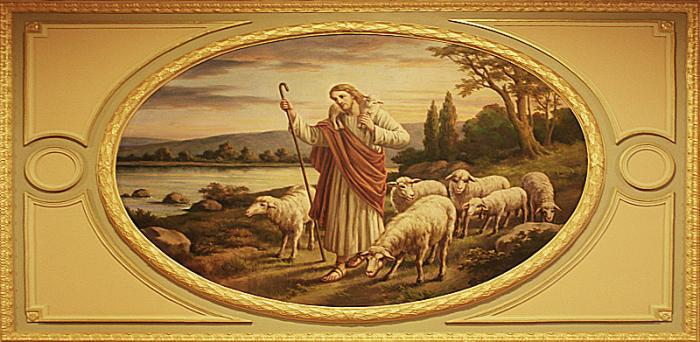
THE GOOD SHEPHERD is Christ as the epitome of all virtue seeking out the Lost Sheep.
The neighborhood in which John the Baptist had evangelized is the scene portrayed in the mural of the Good Shepherd, Whose careful pursuit is not for the children of the faith alone and for the righteous, but also for those who have wandered from the fold and for those who have forsaken the paths of virtue. The Divine Shepherd is represented as returning to the pasture land with a stray lamb on His shoulder, a staff in His hand, His joy in the success of His search apparent. He is bringing home the lost sheep to join the 99.
The picture of the Gospel story of the second Sunday after Easter is that of the beautiful parable uttered by our Lord in Jerusalem. The Jews were a pastoral people, and there are still many flocks of sheep in the Holy Land, grazing on the mountain slopes and in the valleys. If necessary, the shepherd gives his life for his sheep. Love and loyalty to his flock, even unto death, are the chief characteristics of the good shepherd. And, as our Lord said, "I know mine, and mine know Me," so the good shepherd knows his own sheep, and keeps himself ready to lay down his life to protect his flock.
When the voice of our Saviour calls, the strayed sheep leaves the brambles of self-will and the wilderness of error to come home under the light of His guidance and help.
There is a fine pictorial feeling for atmosphere, an idyllic charm in the positive setting of this picture with a sense of real distance of a river country ending in a mountain and wilderness in the background. The landscape style is sincere and graceful, with concentration on the figures of the Good Shepherd and the fold as well as on the lost sheep; the color is quiet, low-toned, a green, grey, and brown harmony that is refined, yet distinctive. The Good Shepherd is a sensitive mural painted with winning genius and charm.
Student Murals on Campus

Graphic Design majors Emmanuel Adjei '18 and C. Jakob Santos created a mural to celebrate the Entrepreneur Launch Pad on the third floor of the Learning Commons during the fall of 2016. The mural represents the positive effects of collaboration and creativity.

In May 2019, Matt Catanzaro '20 and Nick Arcarese '22 painted the University motto “Sanctitas, Scientia, Sanitas,” Latin for “Holiness, Knowledge, Health,” on the L-shaped masonry wall behind the Insalaco Center for Studio Arts.
Matt Catanzaro '20 painted the university mascot, the Marywood Pacer, against the university name in gold letters in May 2019. The fence mural, about 10 feet tall and 20 feet long, is located behind the Learning Commons.

The Art Therapy Mandala is a giant wooden puzzle that's made from the collected pieces of over two hundred participants from an Art Therapy Symposium. Encircled on the mandala are the inspired words of Sr. Corita Kent, IHM: "To create means to relate, the root meaning of the word ‘art’ is to fit together, and we all do this every day.”